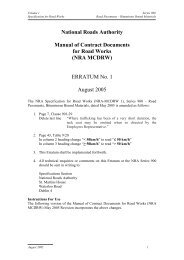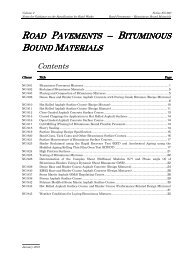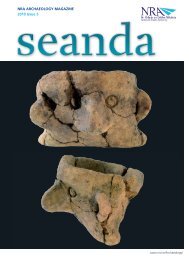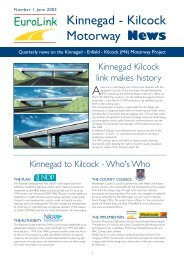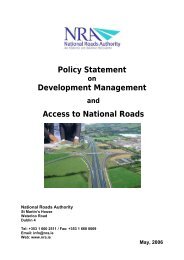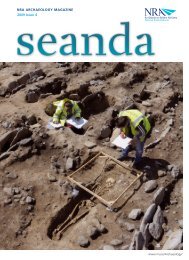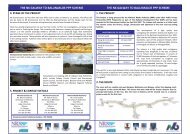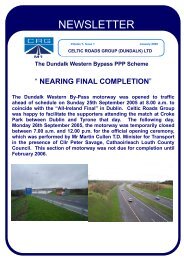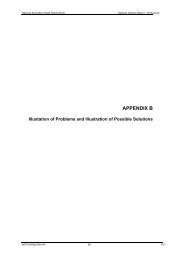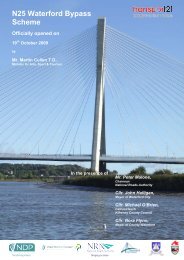NRA TA 85 Guidance on Minor Improvements to National Roads
NRA TA 85 Guidance on Minor Improvements to National Roads
NRA TA 85 Guidance on Minor Improvements to National Roads
Create successful ePaper yourself
Turn your PDF publications into a flip-book with our unique Google optimized e-Paper software.
<str<strong>on</strong>g>NRA</str<strong>on</strong>g> <str<strong>on</strong>g>TA</str<strong>on</strong>g> <str<strong>on</strong>g>85</str<strong>on</strong>g> <str<strong>on</strong>g>Guidance</str<strong>on</strong>g> <strong>on</strong><br />
<strong>Minor</strong> <strong>Improvements</strong> <strong>to</strong><br />
Nati<strong>on</strong>al <strong>Roads</strong><br />
2012 <str<strong>on</strong>g>NRA</str<strong>on</strong>g> CONFERENCE<br />
LIMERICK<br />
Presented by:<br />
Eddie Murphy &<br />
Bryan Kennedy<br />
Kildare Nati<strong>on</strong>al <strong>Roads</strong> Office
What is <str<strong>on</strong>g>NRA</str<strong>on</strong>g> <str<strong>on</strong>g>TA</str<strong>on</strong>g><str<strong>on</strong>g>85</str<strong>on</strong>g>/11 and what is it’s purpose?<br />
• It is a Technical Advice Note that provides guidance <strong>on</strong> the<br />
design principles <strong>to</strong> be c<strong>on</strong>sidered when implementing <strong>Minor</strong><br />
Improvement and Road Safety Improvement Schemes <strong>on</strong><br />
Nati<strong>on</strong>al <strong>Roads</strong>.<br />
• <str<strong>on</strong>g>NRA</str<strong>on</strong>g> <str<strong>on</strong>g>TA</str<strong>on</strong>g><str<strong>on</strong>g>85</str<strong>on</strong>g>/11 supersedes the Oc<strong>to</strong>ber 2006 versi<strong>on</strong> of <str<strong>on</strong>g>NRA</str<strong>on</strong>g><br />
IAN <str<strong>on</strong>g>85</str<strong>on</strong>g>/06 (<strong>Minor</strong> <strong>Improvements</strong> <strong>to</strong> Existing Nati<strong>on</strong>al <strong>Roads</strong>).
What does it apply <strong>to</strong>?<br />
• <strong>Minor</strong> Improvement Schemes<br />
• Road Safety Improvement Schemes<br />
What doesn’t it apply <strong>to</strong>?<br />
• Maintenance Schemes
Definiti<strong>on</strong>s<br />
<strong>Minor</strong> Improvement Scheme<br />
“Is an upgrade <strong>to</strong> an existing secti<strong>on</strong> of substandard road less<br />
than 2km in length where a design element or combined set of<br />
design elements are improved”.<br />
A Road Safety Improvement Scheme<br />
“Is a Schemes that specifically targets secti<strong>on</strong>s of the network<br />
with high collisi<strong>on</strong> rates <strong>to</strong> improve road safety”.
Definiti<strong>on</strong>s<br />
Maintenance Schemes<br />
“predominantly involve pavement works and other road feature<br />
maintenance works such as;<br />
• overlay and inlay works which regulate the camber of the<br />
existing road i.e. return the camber <strong>to</strong> its original shape;<br />
• the introducti<strong>on</strong> of new traffic signs and road markings”
<strong>Minor</strong> <strong>Improvements</strong><br />
Objective:<br />
The objective of a <strong>Minor</strong> Improvement Scheme is <strong>to</strong> achieve a<br />
localised improvement appropriate <strong>to</strong>, and c<strong>on</strong>sistent with, the<br />
characteristics of the adjacent secti<strong>on</strong>s of the route.<br />
The aim of a <strong>Minor</strong> Improvement Scheme should be:<br />
• To improve Road Safety and<br />
• To make better use of the existing road network
<strong>Minor</strong> <strong>Improvements</strong> (c<strong>on</strong>td.)<br />
Example of elements of the road that might be improved would<br />
include:<br />
• Applying superelevati<strong>on</strong> in accordance with <str<strong>on</strong>g>NRA</str<strong>on</strong>g> TD 9<br />
• <strong>Improvements</strong> <strong>to</strong> the horiz<strong>on</strong>tal and vertical alignment<br />
• Upgrading the road cross-secti<strong>on</strong><br />
• Sightline <strong>Improvements</strong> at juncti<strong>on</strong>s
Road Safety Improvement Schemes<br />
Objective<br />
“…<strong>to</strong> achieve a reducti<strong>on</strong> in the frequency, and severity of<br />
collisi<strong>on</strong>s which have occurred <strong>on</strong> this secti<strong>on</strong> of the<br />
Network”
Who is the Road Authority?<br />
• For <strong>Minor</strong> Improvement Schemes the Road Authority shall be<br />
the relevant Local Authority resp<strong>on</strong>sible for the Scheme.<br />
Relevant Secti<strong>on</strong> in the <str<strong>on</strong>g>NRA</str<strong>on</strong>g><br />
• <strong>Minor</strong> Improvement Scheme – Pavement Maintenance<br />
Secti<strong>on</strong>, Network Operati<strong>on</strong>s.<br />
• Road Safety Improvement Schemes – Road Safety Engineering<br />
Secti<strong>on</strong>.
Preliminary Design Report<br />
Objective<br />
“…<strong>to</strong> address and present issues relating <strong>to</strong> compliance with the<br />
relevant parts of the <str<strong>on</strong>g>NRA</str<strong>on</strong>g> DMRB for the opti<strong>on</strong>s c<strong>on</strong>sidered”<br />
Secti<strong>on</strong> 2.2 of <str<strong>on</strong>g>TA</str<strong>on</strong>g><str<strong>on</strong>g>85</str<strong>on</strong>g> states<br />
“ A copy of the Preliminary Design Report shall be issued <strong>to</strong> the<br />
<str<strong>on</strong>g>NRA</str<strong>on</strong>g> Standards Secti<strong>on</strong> for their informati<strong>on</strong>”
C<strong>on</strong>tents of The Preliminary Design Report
Preliminary Design Report<br />
Table 2/1 of <str<strong>on</strong>g>TA</str<strong>on</strong>g><str<strong>on</strong>g>85</str<strong>on</strong>g>/11
Preliminary Design Report
Chapter 3 Design Standards<br />
Design Speed<br />
• Related <strong>to</strong> road characteristics, not manda<strong>to</strong>ry speed limit.<br />
• Geometric Elements c<strong>on</strong>sistent with road character.<br />
• Calculated for the secti<strong>on</strong> of road being improved and for the<br />
2km either side using the method c<strong>on</strong>tained in Chapter 1 of<br />
<str<strong>on</strong>g>NRA</str<strong>on</strong>g> TD9 “Road Link Design”.
Chapter 3 Design Standards<br />
Horiz<strong>on</strong>tal Alignment<br />
• Shall be c<strong>on</strong>sistent with the existing road network for 2km<br />
either side of the proposed scheme.<br />
• Shall c<strong>on</strong>sider the impact of any realignment <strong>on</strong> existing<br />
accesses and juncti<strong>on</strong>s.<br />
• Shall ensure that the proposed horiz<strong>on</strong>tal alignment design<br />
does not introduce new safety problems
Chapter 3 Design Standards<br />
Horiz<strong>on</strong>tal Alignment<br />
• Where adverse camber is present superelevati<strong>on</strong> shall be<br />
designed in accordance with <str<strong>on</strong>g>NRA</str<strong>on</strong>g> TD 9 “Road Link Design”.<br />
• Where this cannot be achieved superelevati<strong>on</strong> should be<br />
c<strong>on</strong>sistent with the level of superelevati<strong>on</strong> provided <strong>on</strong><br />
adjacent secti<strong>on</strong>s as a minimum, and shall be recorded as a<br />
Departure.
Chapter 3 Design Standards<br />
Horiz<strong>on</strong>tal Alignment<br />
• Applied superelevati<strong>on</strong> shall not adversely affect existing<br />
drainage, vehicular accesses or juncti<strong>on</strong>s .<br />
• Examples from Chapter 4 of <str<strong>on</strong>g>NRA</str<strong>on</strong>g> <str<strong>on</strong>g>TA</str<strong>on</strong>g> <str<strong>on</strong>g>85</str<strong>on</strong>g>/11
Chapter 3 Design Standards<br />
Vertical Alignment<br />
• Alterati<strong>on</strong>s shall be carried out <strong>to</strong> satisfy the Desirable<br />
Minimum requirements of <str<strong>on</strong>g>NRA</str<strong>on</strong>g> TD 9 “Road Link Design”.<br />
• Where it is not possible <strong>to</strong> meet the Desirable Minimum<br />
requirements it shall be recorded as a Departure.<br />
• Shall ensure that the proposed vertical design does not<br />
inadvertently introduce hidden dips.
Chapter 3 Design Standards<br />
Vertical Alignment<br />
• Example from Chapter 4 of <str<strong>on</strong>g>NRA</str<strong>on</strong>g> <str<strong>on</strong>g>TA</str<strong>on</strong>g> <str<strong>on</strong>g>85</str<strong>on</strong>g>/11
Chapter 3 Design Standards<br />
Cross-Secti<strong>on</strong><br />
• Cross-secti<strong>on</strong> should comply with Table 6/1 of <str<strong>on</strong>g>NRA</str<strong>on</strong>g> TD 9<br />
“Road Link Design” where possible & should also c<strong>on</strong>sider the<br />
future route strategy for the existing road.<br />
• Any reducti<strong>on</strong> in cross-secti<strong>on</strong> shall be recorded as a<br />
Departure. Example from Chapter 4 of <str<strong>on</strong>g>NRA</str<strong>on</strong>g> <str<strong>on</strong>g>TA</str<strong>on</strong>g> <str<strong>on</strong>g>85</str<strong>on</strong>g>/11
Chapter 3 Design Standards<br />
Overtaking Value<br />
• Provide the best improvement <strong>to</strong> overtaking opportunities<br />
that can be ec<strong>on</strong>omically devised<br />
• Principle objective of some minor improvements may be <strong>to</strong><br />
provide enhanced overtaking opportunity (achieve the<br />
minimum overtaking value specified in Table 7/3 of <str<strong>on</strong>g>NRA</str<strong>on</strong>g> TD 9<br />
“Road Link Design”.<br />
• Shall ensure that overtaking and n<strong>on</strong>-overtaking secti<strong>on</strong>s<br />
clearly identified
Chapter 3 Design Standards<br />
Overtaking Value<br />
• C<strong>on</strong>siderati<strong>on</strong>s should be made of nearside overtaking<br />
secti<strong>on</strong>s at juncti<strong>on</strong> locati<strong>on</strong>s<br />
• Examples from Chapter 4 of <str<strong>on</strong>g>NRA</str<strong>on</strong>g> <str<strong>on</strong>g>TA</str<strong>on</strong>g> <str<strong>on</strong>g>85</str<strong>on</strong>g>/11.
Chapter 3 Design Standards<br />
Juncti<strong>on</strong>s & Access Modificati<strong>on</strong>s<br />
• <strong>Minor</strong> improvements involving upgrades <strong>to</strong> existing juncti<strong>on</strong>s<br />
shall comply with the requirements of <str<strong>on</strong>g>NRA</str<strong>on</strong>g> TD 9 and <str<strong>on</strong>g>NRA</str<strong>on</strong>g> TD<br />
41-42 “Geometric Design of Major/<strong>Minor</strong> Priority Juncti<strong>on</strong>s<br />
and Vehicular Access <strong>to</strong> Nati<strong>on</strong>al <strong>Roads</strong>” where possible.<br />
• Forward visibility and visibility splays at juncti<strong>on</strong>s and<br />
accesses, which are currently below <str<strong>on</strong>g>NRA</str<strong>on</strong>g> DMRB standards,<br />
shall not be adversely affected and where possible should be<br />
improved.
Chapter 3 Design Standards<br />
Juncti<strong>on</strong>s & Access Modificati<strong>on</strong>s<br />
• Departures shall not be permitted <strong>to</strong> reduce visibilities below<br />
standard where existing visibilities are above <str<strong>on</strong>g>NRA</str<strong>on</strong>g> DMRB<br />
standards. Examples from Chapter 4 of <str<strong>on</strong>g>NRA</str<strong>on</strong>g> <str<strong>on</strong>g>TA</str<strong>on</strong>g> <str<strong>on</strong>g>85</str<strong>on</strong>g>/11.
Chapter 3 Design Standards<br />
Safety Barrier<br />
• If the Design Speed is 100km/h or greater, the requirements<br />
of <str<strong>on</strong>g>NRA</str<strong>on</strong>g> TD 19 Safety Barriers shall apply.<br />
• A review of the operati<strong>on</strong>al characteristics of any existing<br />
barriers for compliance with <str<strong>on</strong>g>NRA</str<strong>on</strong>g> TD 19 shall be carried out.<br />
• The operati<strong>on</strong>al characteristics of any existing safety barriers<br />
which are retained shall not be affected.
Chapter 3 Design Standards<br />
Safety Barrier<br />
• Where it is not feasible <strong>to</strong> apply the requirements of <str<strong>on</strong>g>NRA</str<strong>on</strong>g> TD<br />
19 the following alternative acti<strong>on</strong>s shall be c<strong>on</strong>sidered;<br />
Removal of the hazard.<br />
Relocati<strong>on</strong> of the hazard <strong>to</strong> a safer positi<strong>on</strong>.<br />
Redesign of the hazard <strong>to</strong> reduce the danger <strong>to</strong> road users.<br />
Provide warning signage in advance of the hazard.<br />
Mitigate the presence of the hazard by improved road edge<br />
delineati<strong>on</strong>.<br />
Redesign of the road layout <strong>to</strong> lower the risk.
Chapter 3 Design Standards<br />
Safety Barrier<br />
• <strong>Minor</strong> improvements schemes with a Design Speed less than<br />
100km/h, safety barriers will generally not be required, unless<br />
it is c<strong>on</strong>sidered <strong>to</strong> be a specific hazard.<br />
• However a review of TD19 Safety Barrier is being carried out<br />
and all Nati<strong>on</strong>al <strong>Roads</strong> will be subject <strong>to</strong> a Safety Barrier Risk<br />
Assessment in the future.<br />
• The following is the procedure <strong>to</strong> be followed for the Safety<br />
Barrier Risk Assessment;
Chapter 3 Design Standards<br />
• The Hazard locati<strong>on</strong> and type will be identified by Designers.<br />
• The Designers <strong>to</strong> remove, relocate or redesign hazards <strong>to</strong><br />
remove the need for a safety barrier.<br />
• The need for a barrier will be determined by a designer risk<br />
analysis based <strong>on</strong> the following data:<br />
Collisi<strong>on</strong> Data<br />
Sinuosity<br />
Run off road Data<br />
AADT<br />
• Locati<strong>on</strong>s will be classified as High, Medium and Low Risk
Chapter 3 Design Standards<br />
Drainage<br />
• Shall ensure that surface and sub-surface drainage provisi<strong>on</strong>s<br />
in accordance with HD 33, as amended by the <str<strong>on</strong>g>NRA</str<strong>on</strong>g>, are<br />
included in the design.<br />
• Where existing road drainage provisi<strong>on</strong>s are <strong>to</strong> be<br />
incorporated an assessment of the adequacy of the drainage<br />
system shall be made and should include a review of the<br />
superelevati<strong>on</strong> and l<strong>on</strong>gitudinal gradient.
Chapter 3 Design Standards<br />
Traffic Signs & Road Markings<br />
• <strong>Improvements</strong> <strong>to</strong> existing signs, road markings and reflec<strong>to</strong>rs<br />
shall comply with the requirements of the Traffic Signs<br />
Manual.
Chapter 3 Design Standards<br />
N<strong>on</strong> Mo<strong>to</strong>rised Road Users<br />
• The design shall address the needs of N<strong>on</strong> Mo<strong>to</strong>rised Road<br />
Users.<br />
• An assessment of existing footways/cycle tracks in the vicinity<br />
of the minor improvement shall be undertaken.<br />
• Where footways/cycle tracks are required, the verge shall be<br />
widened accordingly <strong>to</strong> accommodate these features.
Chapter 3 Design Standards<br />
Road Safety Audits<br />
• All schemes shall be subject <strong>to</strong> Road Safety Audits<br />
During Design<br />
Completi<strong>on</strong> of C<strong>on</strong>structi<strong>on</strong><br />
• Road Safety Audits should be carried out in accordance with<br />
<str<strong>on</strong>g>NRA</str<strong>on</strong>g> HD 19 Road Safety Audits.
Example 1: N72 Cappagh Bends<br />
• Realignment of Horiz<strong>on</strong>tal Geometry<br />
• Realignment of Vertical Geometry<br />
• Applicati<strong>on</strong> of Superelevati<strong>on</strong><br />
• Nearside Overtaking Opportunity<br />
• Increase in S<strong>to</strong>pping Sight Distance<br />
• Increase in Visibility from Juncti<strong>on</strong><br />
• Removal of Road Side Hazards<br />
• Installati<strong>on</strong> of New Safety Barrier
Thank You for Your Attenti<strong>on</strong><br />
We will now take any questi<strong>on</strong>s






